The Connection between Minimalist Home Decor and Sustainability
Table of Contents
How Minimalism Home Decor Can Lead to Sustainable Living
Living an eco-friendly lifestyle wth minimalism in mind is becoming increasingly important, and home decor has a large part to play in that. On the surface, minimalism and sustainability can appear to be two ends of a spectrum; minimalism referring to simple interiors with less clutter and a focus on quality, sustainable items, and sustainability relating to taking care of the environment and reducing the use of natural resources. However, the two concepts are actually closely linked and one can directly contribute to the other.
In this article, we look at the connection between minimalism home decor and sustainability, and how they are intertwined.
1. Why Quality Matters in Home Decor
In order to recognize how minimalism and sustainability are connected, it’s important to recognize why quality is important. When buying home decor items, quality should be prioritized. Quality pieces are made to last, meaning you won’t have to replace them more often, ultimately meaning fewer items to buy, making it more sustainable. Additionally, quality means fewer resources used to make the items, contributing to a greener lifestyle.
2. Reusing and Upcycling: The Sustainable Rationale behind Minimalism
Minimalist home decor embraces the concept of ‘less is more’, a sustainability ethos. The idea is to find items which you can repurpose for a range of tasks, or mix and match with items you already have. This not only creates a stylish living space, but it’s also a sustainable choice.
You don’t have to buy new items all the time; you can search second-hand instead or re-use items you already own. Upcycling is also a great way of breathing new life into items. This can easily be done with pre-loved furniture, and can make a huge difference to your home.
3. Reducing emissions with Minimalism
Furniture and fixtures bought from overseas can often come with a hefty price tag in terms of emission levels. They’re usually transported from overseas on boats, planes, or trucks, releasing large amounts of carbon dioxide into the atmosphere.
By keeping furniture to a minimum, you reduce the transportation time and overall emissions released. Additionally, you can try and source furniture locally which does not have to be shipped from elsewhere and is more eco-friendly.
4. Sustainable Benefits of a Decluttered Home
Decluttering your home not only makes it look great and helps your stresses, but it can also help reduce consumption in your home. When there are fewer items in your home, you’re likely to use your possessions more thoughtfully and reduce the amount of consumption.
In addition, reducing the amount of clutter in your home creates space to add sustainable items, such as solar window chargers and heaters. This is one of the key elements of making the minimalism movement and sustainability work hand-in-hand.
Conclusion
Minimalism home decor and sustainability are closely linked through quality, reusing and upcycling, reducing emissions, and the benefits of a decluttered home. By adding minimalism into your lifestyle, you can find more sustainable and eco-friendly alternatives.
By embracing minimalism as a home decor trend and being conscious about where you source materials from, it’s possible to have beautiful, stylish and sustainable home.






